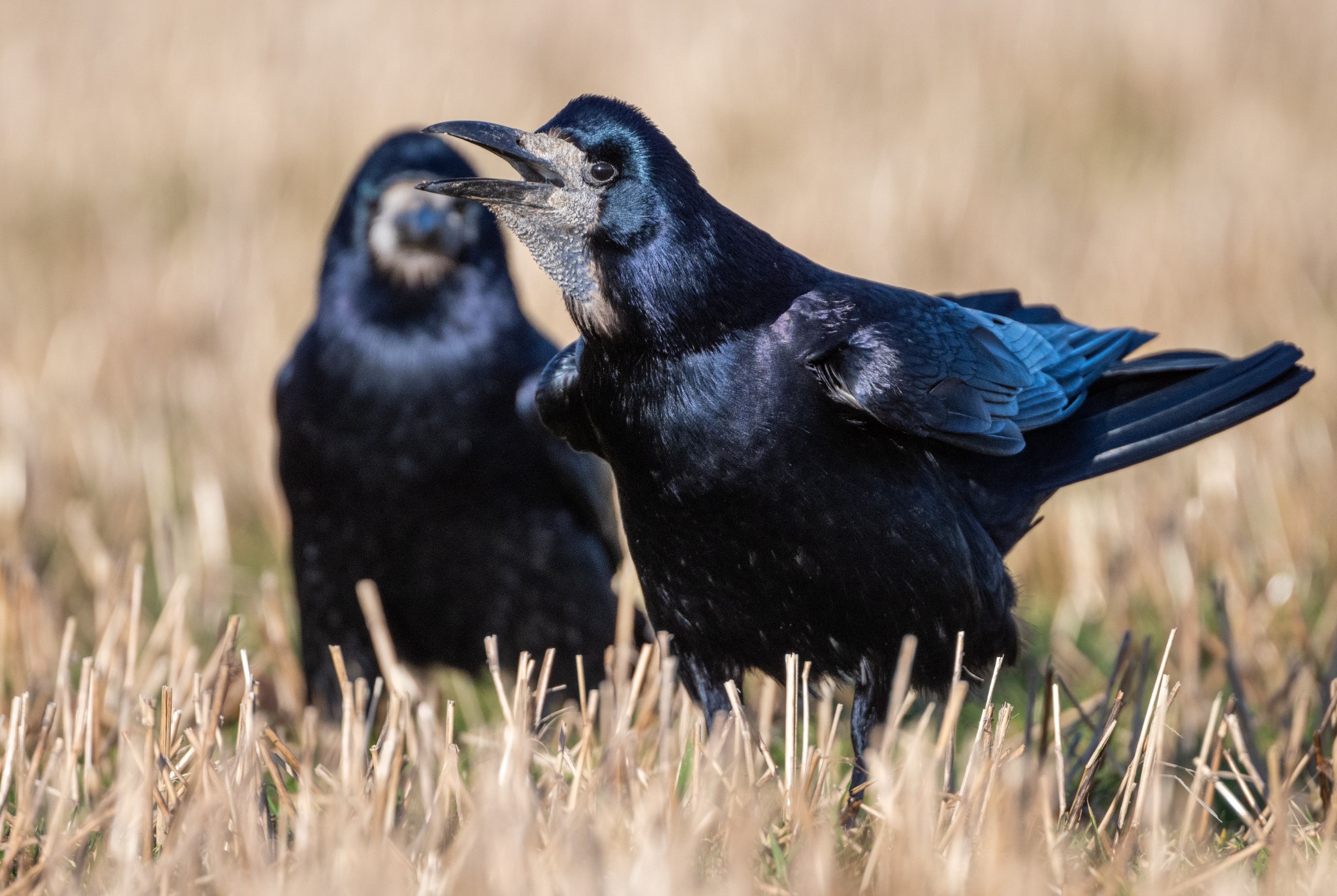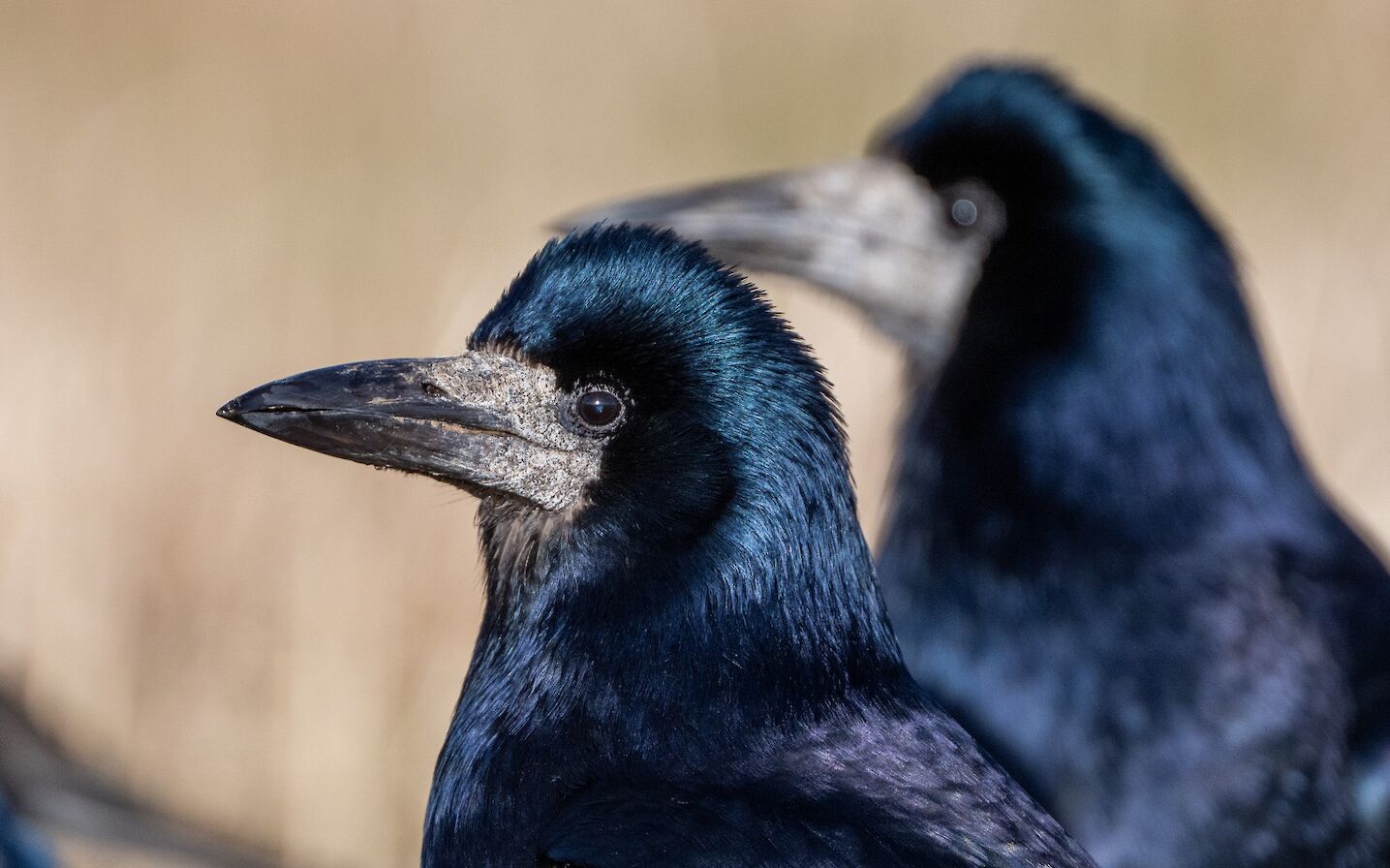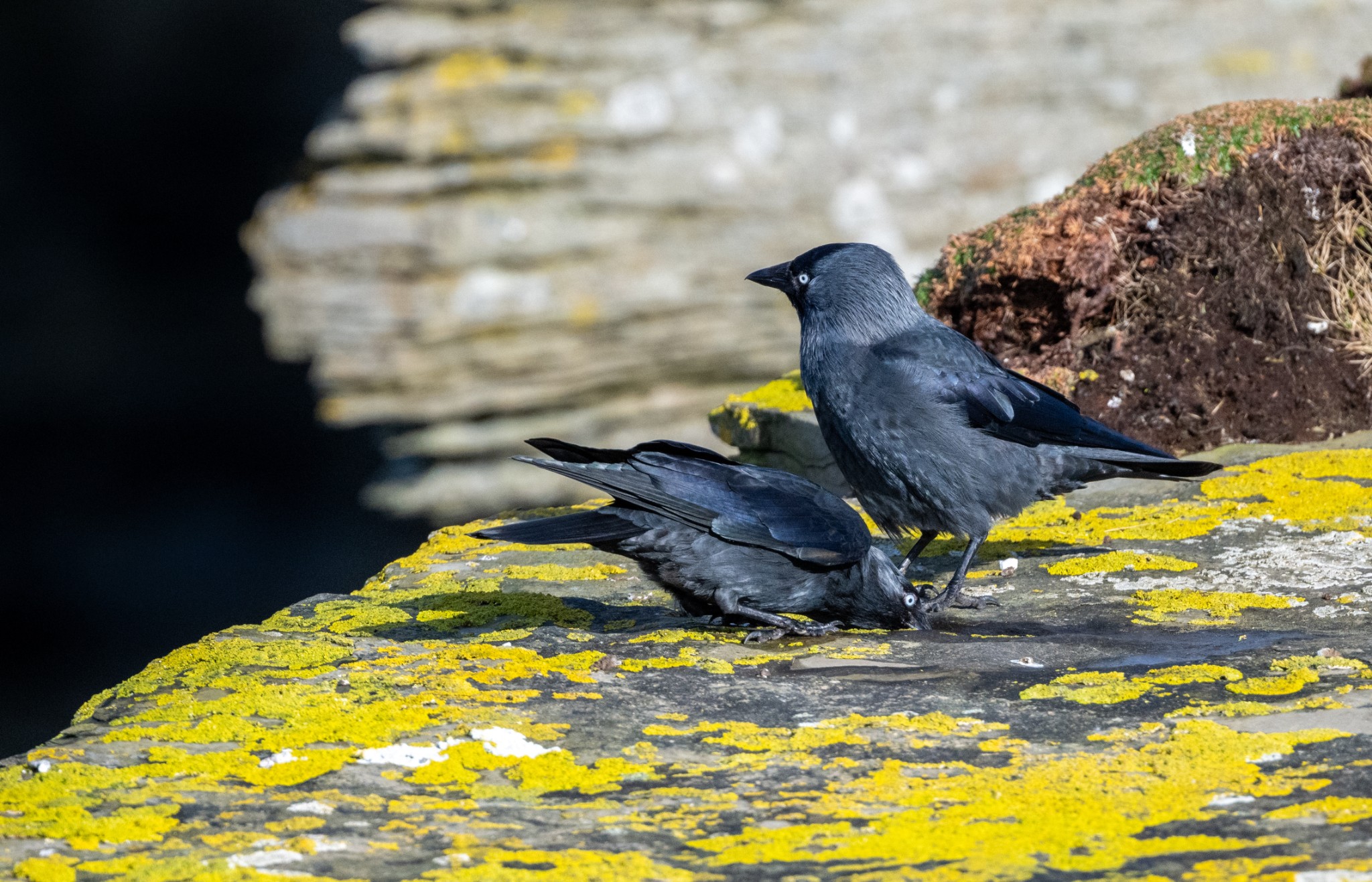This month’s article came about because I had failed to photograph what I had initially set out to take images of, namely brown hares.
They have been very active in grazed and stubble fields all around the Orkney mainland, but they are not an easy mammal to photograph. I’ve had some success before simply photographing out of the car window but it’s not ideal. So, I set up a hide at the edge of a field after a tip off from some friends that they had regular hare activity near their house.
From my filming window I could see the stubble field spread out before me and had a wide vista should any hares run into view. Unfortunately, the individual that did settle in front of the hide did little else but settle, too far away and not really doing anything other than the odd twitch.
As I waited, I heard the building familiar calls of rooks and sure enough a small flock of around 20 birds landed in the field and started feeding. The sun hadn’t long been up but it made me look at the rook in a whole new light. It often works this way, you set out for one thing and then another unexpected opportunity arises.
They walked as they fed and ended up very close to the hide. You wouldn’t think this would be a problem but all members of the crow family are intelligent birds, and whilst some are curious, they can also be wary. I tend to think most wild creatures know when something ‘isn’t right’ and so any movement from me within the hide would likely mean them flying off.
For the most part we see the rook as simply a black bird, or even just as a ‘crow’. But there are eight species in the UK which belong to what is known as the corvids (Corvidae family) or sometimes just the crow family. These include magpie, jay and choughs but in Orkney we can whittle these down to just the raven, jackdaw, rook, hooded crow and the odd sighting of a carrion crow.
But on this morning the rook was definitely not just a black crow. In the direct sunlight its plumage was iridescent and really quite something to behold. There is a debate about what constitutes purple or violet or indigo so I’ll let you decide from the images. For me it’s even more subtle than that with many shades of blue, the feathers changing colour as they moved. A juvenile rook is here too and at first glance could be mistaken for the all-black carrion crow as it lacks the bare face of the adult.
They were noisy too. They stoop and fan their tails out as they give a full chested rasping croak. Seeing them up close like this gives me a chance to really study the face and well, as much as their bright plumage has elevated their looks on this particular morning the bare grey patch at the base of the bill does make it one that’s hard to love! The bill itself is dagger shaped and they put it to good use feeding on worms and invertebrates in the soil.
I can see St Magnus Cathedral from my house in Kirkwall and so during the autumn and winter I’m treated to the sight and sound of them as they fly to their roosts. A short walk away and I can be underneath the trees at the Earl’s Palace to watch the nest-building antics of my local rooks. Orkney really is ideal for them, an almost unlimited number of agricultural fields in which to forage and the trees of Kirkwall, Stromness and Firth in which to establish their rookeries.
Often found alongside rooks, in both the trees and in the air, is the smallest of our resident corvids and my favourite, the jackdaw. I can’t help feel that they are mischievous but essentially good-natured birds, though I’m anthropomorphising a little.
They are a dashing little bird, a mix of greys, blacks and charcoals and with a striking ice blue eye. The place I like to see them best is on the high cliffs and a visit to Marwick Head should ensure some sightings. The day I walked the slope up to the Kitchener’s Memorial there were 16 jackdaws involved in aerial acrobatics. Dainty in size, they are nonetheless daring in flight and seem to think nothing of dropping like a stone and corkscrewing at the last second in order to land on the sheer cliffs where these birds will also nest. These 16 birds likely constituted 8 pairs as they form long-term partnerships and can stay together all-year-round.
Their calls are a welcome addition to the cacophony of those below, chief amongst them the ‘gurring’ of common guillemots. As I watch them tumble, the sound of ‘kya-kya’ fills the air, cutting through the crashing waves. Jackdaws are our most social and gregarious crow species, often found in the company of rooks, hooded crows and even ravens in their different habitats. It may sound to us as though their calls are just simply that, but new research shows that these are group vocalisations, and may be communicating when to leave their roost sites in the morning. Not just one bird leaving and the other following, but rather a democratic natter before consensus is reached.
Perhaps our most adaptable corvid however is the hooded crow, or simply ‘hoodie’ as we tend to call it. It’s probably a bird we tend to overlook, dismiss even, given the antipathy some hold towards corvids, but they are common throughout Orkney and you would be hard pressed to go on a walk and not see one. In the natural world we are drawn to the specialists, the fastest, the strongest, the deepest diving. But what makes the hooded crow so successful is that it is none of these things, its superlative is that it is a generalist. Their omnivorous approach to feeding and their adaptable approach to breeding means in Orkney you can find it nesting in moorland, in trees, on cliffs, in quarries and an admittedly more troublesome place, telegraph poles.
Whilst I did see some rooks picking amongst some cast seaweed the other day, the crow you are most likely to see on the shore is the hoodie. A behaviour that I love to watch and first saw on the isle of Arran is how the hoodie deals with a prey item commonly found as the tide goes out, the whelk. More recently I saw two different birds applying the same behaviour, one at the Hatston slip where they sometimes go to pick up the scraps of the crabs landed there by fishermen, and the other just further along the shore below the Ortak building.
Whelks have a fairly thick lipped shell with the animal itself safely ensconced inside. So, the hoodie rises into the air with it and simply drops it from a height of about 15 or 20 metres onto the rocks below. Rarely does the shell crack first time and so the manoeuvre is repeated until it does.
With its pied appearance I think hoodies look quite striking, more so than their cousin the carrion crow. Indeed, until 2002 the hoodie and the carrion crow were treated as a sub-species of the same species which just occupied different parts of the country - the carrion crow favouring the lowlands and the south, the hoodie not encountered until you cross north past the Scottish central belt. Where their paths cross, they can interbreed though are now recognised as separate species.
It’s with a little hesitancy that I move on to the last and largest of our corvids, the raven.
It is a bird that has been both revered and persecuted and probably falls somewhere in the ‘difficult’ category in the Orkney psyche. These days it is mostly a bird of sea cliffs, though some can be found nesting in trees and inland crags.
I recently photographed a pair of Ravens who were nest building below an overhang of some inaccessible cliffs on our west coast. The sea spray from below hung in the air, diffused by the setting sun. All I could make out was the silhouette of these imposing birds and it wasn’t hard to imagine this bird as something ‘other’, a spirit or shape shifter.
Numerous cultures, particularly in North America and Scandinavia, have projected human characteristics onto ravens. Norse mythology in particular saw ravens as part of a manifestation of the god Odin where they were all-knowing messengers and protectors.
By the rise of the Scottish sporting estate in the mid-19th century however this reverence was long gone. Where ‘control’ became an important part of upland management in a broader context, the raven became cautious and so retired to those inaccessible cliffs. That it is intelligent is not contested and in the same way that the rock doves I can see nearby are paying me little attention, it feels like these ravens are aware that I’m specifically watching them.
It’s their awareness that has helped me in the past amongst the Hoy hills. As their distinctive ‘cronking call’ echoed across the Dwarfie Hammars, my eyes were first drawn to them and then to the subject of their ire, a golden eagle. A sight and relationship no doubt played out daily amongst the hills of Scotland.
Find out more about Raymond’s work via his official website. You can also find him on Facebook, Twitter and Instagram.





